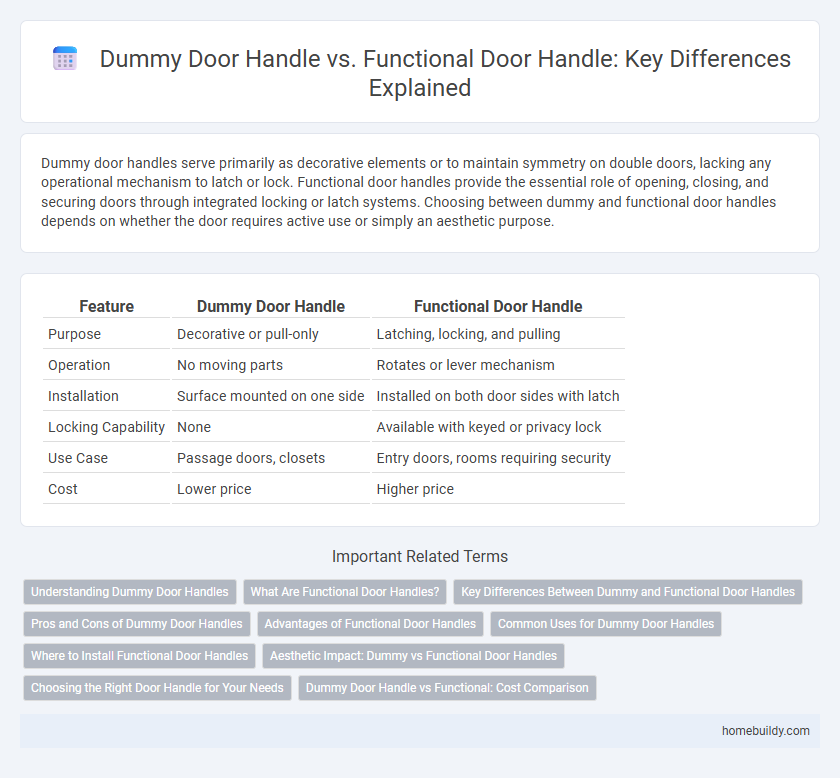Dummy door handles serve primarily as decorative elements or to maintain symmetry on double doors, lacking any operational mechanism to latch or lock. Functional door handles provide the essential role of opening, closing, and securing doors through integrated locking or latch systems. Choosing between dummy and functional door handles depends on whether the door requires active use or simply an aesthetic purpose.
Table of Comparison
| Feature | Dummy Door Handle | Functional Door Handle |
|---|---|---|
| Purpose | Decorative or pull-only | Latching, locking, and pulling |
| Operation | No moving parts | Rotates or lever mechanism |
| Installation | Surface mounted on one side | Installed on both door sides with latch |
| Locking Capability | None | Available with keyed or privacy lock |
| Use Case | Passage doors, closets | Entry doors, rooms requiring security |
| Cost | Lower price | Higher price |
Understanding Dummy Door Handles
Dummy door handles serve primarily as decorative hardware without any latch or locking mechanism, ideal for doors that do not require opening, such as closet or pantry doors. Functional door handles include a latch or lock mechanism, allowing users to open, close, and secure the door, making them essential for entryways and rooms requiring privacy. Understanding the distinction helps in selecting the appropriate handle based on door operation needs and aesthetic preferences.
What Are Functional Door Handles?
Functional door handles are designed to operate the door latch mechanism, allowing doors to open and close securely. Unlike dummy door handles, which serve purely decorative purposes or act as pulls without moving parts, functional handles include components such as levers or knobs that engage the lock or latch system. These handles are essential for ensuring access control, security, and ease of use in residential and commercial doors.
Key Differences Between Dummy and Functional Door Handles
Dummy door handles are non-operational hardware pieces primarily used for aesthetic purposes on double doors or closet doors, lacking a latch or locking mechanism. Functional door handles include a latch mechanism that allows the door to open, close, and lock securely, providing practical use and security. The key difference lies in their functionality: dummy handles serve decorative roles while functional handles enable door operation and access control.
Pros and Cons of Dummy Door Handles
Dummy door handles offer a sleek, fixed design ideal for decorative or interior doors without locking mechanisms, providing a clean aesthetic and easy installation. However, their lack of functionality means they cannot operate door latches, making them unsuitable for entry or frequently used doors where security and access control are necessary. Choosing dummy handles optimizes design simplicity but limits practical use in active door scenarios.
Advantages of Functional Door Handles
Functional door handles offer practical benefits such as enabling secure locking mechanisms, providing ease of access, and enhancing safety by allowing controlled entry and exit. Unlike dummy door handles, which serve purely decorative purposes and do not operate a latch or lock, functional handles contribute to the overall security and usability of doors in both residential and commercial settings. Their ergonomic designs improve user comfort and efficiency during daily use.
Common Uses for Dummy Door Handles
Dummy door handles are commonly installed on double doors where only one side requires active operation, providing a consistent appearance without functionality. These handles serve primarily decorative purposes or act as pulls on closet or pantry doors that do not latch. Unlike functional door handles, dummy handles lack internal mechanisms, making them ideal for applications where door operation is unnecessary.
Where to Install Functional Door Handles
Functional door handles are essential for entry and exit points such as front doors, bedroom doors, and bathroom doors where locking or latching is required for security and privacy. These handles are installed on doors needing frequent operation, secure access, or emergency egress, including external doors, office doors, and interior doors with locking mechanisms. Dummy door handles are typically placed on doors without latching needs, like closet or pantry doors, where functionality is unnecessary.
Aesthetic Impact: Dummy vs Functional Door Handles
Dummy door handles offer a sleek, uninterrupted aesthetic ideal for enhancing minimalist or symmetrical design schemes without compromising visual flow. Functional door handles, while providing practicality, can introduce visual complexity through keyholes, locks, or mechanisms that may disrupt design cohesion. Selecting between dummy and functional handles significantly influences the overall door appearance, balancing aesthetic appeal with usability requirements.
Choosing the Right Door Handle for Your Needs
Choosing the right door handle depends on its intended function: dummy door handles are non-operable and purely decorative, ideal for closets or double doors where one side remains fixed. Functional door handles include latch or lock mechanisms, providing security and ease of use for entryways and frequently accessed rooms. Assessing the need for locking, usage frequency, and aesthetic preference ensures the best selection between dummy and functional door handles for any interior or exterior door.
Dummy Door Handle vs Functional: Cost Comparison
Dummy door handles are typically more affordable than functional door handles due to their lack of internal mechanisms, costing between $10 and $30 on average. Functional door handles, which include locking and latching components, range from $40 to $150 depending on the complexity and security features. The installation cost also differs, with dummy handles requiring minimal effort compared to the more involved process for functional handles that connect to a door latch or lock system.
dummy door handle vs functional door handle Infographic

 homebuildy.com
homebuildy.com